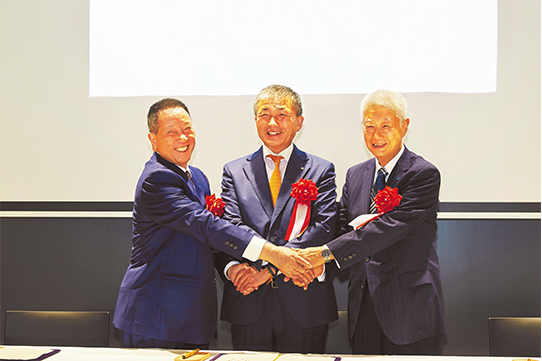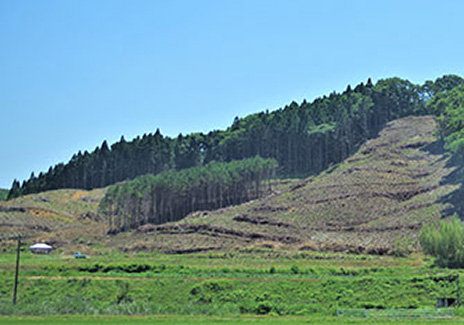We have been developing fireproof wooden buildings using timber that requires less energy for manufacturing and processing with lower CO2 emissions.
We are also planting trees based on the idea of planting to replace what we use. Trees absorb CO2 in the air and provide a carbon dioxide fixing solution as they grow, so an abundance of trees in the nation’s land can help cut down CO2 levels. Furthermore, trees that are ready to be cut for timber have a reduced ability to absorb CO2 , so while we cut down trees as building materials, we also plant new trees to replace them. In this way, we are contributing to maintaining the proportion of young trees that absorb CO2 well at a certain level. Through this initiative for fireproof wooden buildings, we are promoting forest circulation by using, planting, growing, and cutting down trees, which in turn reduces CO2 emissions and leads to efforts to conserve biodiversity.
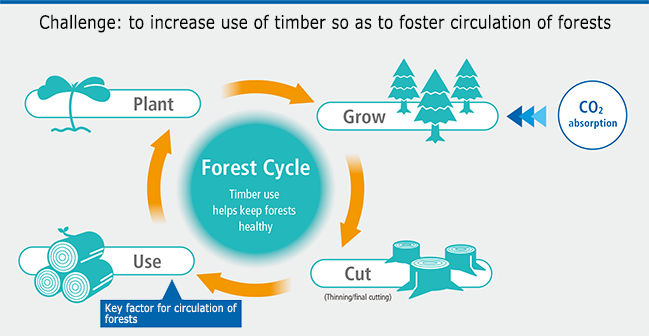
Basic Policy for Promoting Wooden Buildings
| To Spread | Participate in the Wood Change CouncilWe are a member of the Wood Change Council, a networking gathering sponsored by the Forestry Agency which aims to promote the use of timber in the private sector buildings. |
|---|
| To Use | Completion of HULIC &New GINZA 8Construction of HULIC &New Ginza 8 was completed in October 2021, Japan’s first 12-story fireproof wooden (hybrid construction combining wood and steel) commercial building. |
|---|
| To Plant | Execution of environmental afforestationWe execute planting trees in addition to use them in building construction so that we can promote circulation of forests. |
|---|
Example of Use 1: HULIC &New GINZA 8 (Fireproof Commercial Building)
We developed Japan’s first 12-story wooden fireproof commercial building (hybrid construction combining wooden and steel structures) in Ginza, one of our focus areas, in October 2021.
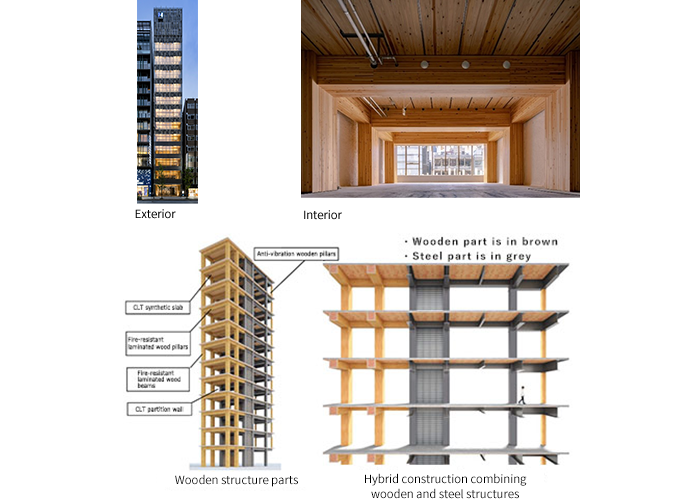
Development and Design Concept
With the objectives of contributing to both the growth of the forest industry and regional revitalization, Hulic used domestic timber for the structure—mostly sugi (cedar) from Fukushima Prefecture—based on the design concept of creating a “forest” in the middle of Ginza. While building with steel and concrete was used in places, we replaced to wood in all sections of the structure where this was possible to create a building with a highly economic and coherent structure.
This 12-story wooden building was created with columns and beams made from timber with a fireproof coating. The hybrid structure combining wooden and steel frame construction takes advantage of several wood-related technologies, such as cross laminated timber (CLT), and vibration-damping walls and pillars made from glued laminated wood. The project which also used wood for exteriors shows the future of cities and structures, with Ginza serving as the model. Inside the building, the fireproofed wooden pillars and beams, as well as the ceiling using CLT, are exposed effectively to carry the feeling of warmth that wood brings to the interior which is also aesthetically pleasing.
Special Features
New technologies
- Japan’s first 12-story wooden fireproof commercial building. The tallest among leasing buildings, as of the time of completion of this property.
Environmental benefits
- Promotes fixation of CO2
Reduces CO2 by increasing the amount of wood used, leading to forest regeneration (forest health)
Approximately 310 m3 of wood was used in the construction of HULIC &New GINZA 8, with the amount of carbon stored in the lumber (CO2 equivalent) totaling 217 t-CO2.*- * Calculated based on the Forestry Agency’s “Guidelines for calculating carbon stored in wood used in buildings” (October 1, 2021) (for all wooden parts)
- Reinvigorates forestry (regional revitalization)
- Reduces CO2 emissions from construction
Eliminates CO2 emissions during structural material manufacturing process (eliminates CO2 that would have been emitted during iron manufacturing, iron processing, concrete manufacturing and other processes) - Facilitates simplified foundations
Lightweight superstructure (above-ground frame section) compared to steel structures and reinforced concrete structures simplifies the foundation structure of the building.
TOPICS
HULIC &New GINZA 8 has received these awards: the Grand Prize (Minister of Land, Infrastructure, Transport and Tourism Award) at the 25th Wood Utilization Competition (sponsored by Japan Association of Timber Youth Groups); the Minister of the Environment Award in the Outstanding Facilities Category in the FY2022 Contest Recognizing Outstanding Facilities for Timber Utilization (sponsored by the Japan Council for Advancement of Timber Utilization); and the Grand Prize (Minister of Land, Infrastructure, Transport and Tourism Award) at the Wood Design Award (sponsored by the Japan Wood Design Association).
Awarded the Grand Prize at the 25th Wood Utilization Competition (Minister of Land, Infrastructure, Transport and Tourism Award)
[Comment from judges]
The HULIC &New GINZA 8 project has been highly rated for tackling the challenge of using wood in high-rise buildings in urban areas. The use of timber from all over Japan for a high-rise structure in Ginza, one of the country’s premier commercial districts, will likely contribute significantly to more use of timber in buildings in the future.
[Wood Utilization Competition]
Started in 1997, this year marked the 25th occasion for the Wood Utilization Competition. The goal is to contribute to the revitalization of the forest industry by exploring new uses for wood and its expanded use.
Many wooden buildings have been constructed in Japan in the 10 years since the enactment of the Act for Promotion of Use of Wood in Public Buildings, etc. aimed at bolstering the use of wood. Recently, we have seen the development of many new wooden materials as well as technology and construction methods, while the laws related to wooden structures have been relaxed. More wooden construction is expected. Given this background, the competition recognizes excellent works that broadly convey the benefits of wood and contributes to more use of wood.
Won Minister of the Environment Award in the Contest Recognizing Outstanding Facilities for Timber Utilization
[Comment from judges]
The main structural components of this building use cedarwood sourced from Shirakawa City, Fukushima Prefecture, establishing collaboration between the Tokyo-based real estate company and local forestry. Materials sourced from the Tama area of Tokyo are also used, contributing to the promotion of local forestry through urban construction and enabling local production for consumption in the metropolis. This project is an advanced example of accelerating the trend toward urban wooden construction by achieving Japan’s first 12-story high-rise wooden hybrid construction with a wooden frame, in this way providing the option of building with wood when designing high-rise buildings.
[Contest Recognizing Outstanding Facilities for Timber Utilization]
The Japan Council for Advancement of Timber Utilization works with local councils in each prefecture and was established in 1984 with the aim of promoting use and increasing the demand for wood. Since 1993, this award has recognized and acknowledged the excellence of the owners, designers, and builders of structures that contribute to the growth of wood use and the unique application of wood.
Received the Grand Prize (Minister of Land, Infrastructure, Transport and Tourism Award) at the Wood Design Award
[Comment from judges]
This building is located in an urban area where symbolic wooden architecture is highly visible, making it a fitting place to showcase its value and appeal. The diverse range of wooden techniques employed is expected to contribute to the growth of wooden construction and this project was rated highly as a model for promoting carbon fixation through wood use in urban settings. This project effectively targets a socially and environmentally conscious customer base unique to the area, offering a comfortable and inviting space that harnesses the soothing qualities of wood. The project successfully maximizes the benefits of using wood and conveys wood’s exceptional properties, such as insulation and moisture absorbency, as well as the sensory appeal of its warmth and softness.
[Wood Design Award]
Japan Wood Design Association, established to conduct research and development, create business, and raise awareness in all fields related to wood design, has defined their initiatives as aimed at helping to resolve social challenges through the use of wood. The Wood Design Award, introduced in 2015, recognizes projects and structures that enrich living and society through wood, showcasing these achievements to Japan and the world.
Example of Use 2: Promoting Conversion to Wood
Along with the development of fireproof wooden buildings, Hulic is actively promoting the use of wood for exteriors and interiors depending on the application and location of the developed property.
-

Entrance Hall
(Charm Suite Yotsuya) -
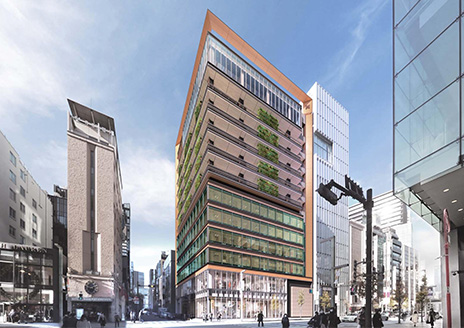
Development plan under consideration of "use of wood"
(Ginza Building Reconstruction Project)
Example of Spread 1: Participate in the Wood Change Council
The Wood Change Council (the Council) is a networking gathering sponsored by the Forestry Agency which aims to promote the use of timber in the private sector buildings. The Council discusses and considers matters related to spreading timber use including identification of issues, direction of solutions and popularization, and aims to create an environment that timber is more easily used as well as to create a platform of spreading the use of timber movement throughout Japan. We participate in the Council with an intent to continuously promote the use of timber.

Example of Planting 1: Planting the Same Amount of Trees Used
Hulic outsources logging, planting, and weeding activities to forestry cooperatives in an effort to plant the same amount of trees as the standing trees used as building materials for fireproof wooden construction. In May 2021, approximately 310m3 of lumber was used in the construction of HULIC &New GINZA 8, a 12 story fireproof wooden (hybrid structure combining wooden and steel frame construction) commercial building completed in October 2021. At the same time, approximately 12,000 cedar saplings were planted (new plantings) across an area of about 4.3 hectares. For five years from 2021, we will continue cutting undergrowth so that the planted cedar saplings will grow healthy.
Cedar sapling newly planted and a mountain
(Fukushima Prefecture)
Example of Planting 2:Conclusion of Forest Resource Utilization Project Agreement (Kawaba Village : Gunma Prefecture)
We have concluded a trilateral agreement with Kawaba Village, Gunma Prefecture and Advance Co., Ltd. on forest resource utilization project through the corporate version of the hometown tax payment system.
We will continue to collaborate and work towards Nature-Positive initiatives.
